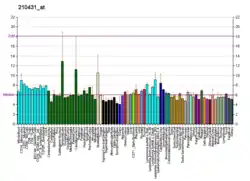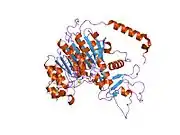Placental alkaline phosphatase
| ALPP | |||||||||||||||||||||||||
|---|---|---|---|---|---|---|---|---|---|---|---|---|---|---|---|---|---|---|---|---|---|---|---|---|---|
 | |||||||||||||||||||||||||
| |||||||||||||||||||||||||
| Identifiers | |||||||||||||||||||||||||
| Aliases | ALPP, ALP, PALP, PLAP, PLAP-1, alkaline phosphatase, placental, ALPI, IAP | ||||||||||||||||||||||||
| External IDs | OMIM: 171800 MGI: 1924018 HomoloGene: 122414 GeneCards: ALPP | ||||||||||||||||||||||||
| |||||||||||||||||||||||||
| |||||||||||||||||||||||||
| |||||||||||||||||||||||||
| Orthologs | |||||||||||||||||||||||||
| Species | Human | Mouse | |||||||||||||||||||||||
| Entrez | |||||||||||||||||||||||||
| Ensembl | |||||||||||||||||||||||||
| UniProt | |||||||||||||||||||||||||
| RefSeq (mRNA) | |||||||||||||||||||||||||
| RefSeq (protein) | |||||||||||||||||||||||||
| Location (UCSC) | Chr 2: 232.38 – 232.38 Mb | n/a | |||||||||||||||||||||||
| PubMed search | [2] | [3] | |||||||||||||||||||||||
| Wikidata | |||||||||||||||||||||||||
| |||||||||||||||||||||||||
Alkaline phosphatase, placental type also known as placental alkaline phosphatase (PLAP) is an allosteric enzyme that in humans is encoded by the ALPP gene.[4][5][6]
Gene
There are at least four distinct but related alkaline phosphatases: intestinal (ALPI), placental (this enzyme), placental-like (ALPPL2), and liver/bone/kidney (ALPL) (tissue-nonspecific). The first three are located together on chromosome 2, whereas the tissue-nonspecific form is located on chromosome 1. The coding sequence for this form of alkaline phosphatase is unique in that the 3' untranslated region contains multiple copies of an Alu family repeat. In addition, this gene is polymorphic and three common alleles (type 1, type 2, and type 3) for this form of alkaline phosphatase have been well-characterized.[6]
Function
Alkaline phosphatase, placental type is a membrane-bound glycosylated dimeric enzyme, also referred to as the heat-stable form, that is expressed primarily in the placenta, although it is closely related to the intestinal form of the enzyme as well as to the placental-like form.[6]
Clinical significance
PLAP is a tumor marker, especially in seminoma[7][8][9] and ovarian cancer (e.g., dysgerminoma).[10] PLAP is reliable only in non-smokers, as smoking interferes with measurement of PLAP,[11] since serum concentrations of PLAP are increased up to 10-fold in smokers and its measurement is therefore of little value in this group.[12]
References
- 1 2 3 GRCh38: Ensembl release 89: ENSG00000163283 - Ensembl, May 2017
- ↑ "Human PubMed Reference:". National Center for Biotechnology Information, U.S. National Library of Medicine.
- ↑ "Mouse PubMed Reference:". National Center for Biotechnology Information, U.S. National Library of Medicine.
- ↑ Kam W, Clauser E, Kim YS, Kan YW, Rutter WJ (Feb 1986). "Cloning, sequencing, and chromosomal localization of human term placental alkaline phosphatase cDNA". Proc Natl Acad Sci U S A. 82 (24): 8715–9. doi:10.1073/pnas.82.24.8715. PMC 391507. PMID 3001717.
- ↑ Henthorn PS, Knoll BJ, Raducha M, Rothblum KN, Slaughter C, Weiss M, Lafferty MA, Fischer T, Harris H (Sep 1986). "Products of two common alleles at the locus for human placental alkaline phosphatase differ by seven amino acids". Proc Natl Acad Sci U S A. 83 (15): 5597–601. Bibcode:1986PNAS...83.5597H. doi:10.1073/pnas.83.15.5597. PMC 386335. PMID 3461452.
- 1 2 3 "Entrez Gene: ALPP alkaline phosphatase, placental (Regan isozyme)".
- ↑ "European Group on Tumor Markers. A European Based Expert Group on Tumor Markers. Germ cell cancer". Archived from the original on 2012-04-26.
- ↑ W. Albrecht; et al. (2004). "Testicular tumor markers: Corner-stones in the management of malignant germ cell tumors" (PDF). J Lab Med. 28 (2): 109–115. doi:10.1515/labmed.2004.018. S2CID 53781946. Archived from the original (PDF) on 2011-01-24.
- ↑ Sturgeon C (August 2002). "Practice guidelines for tumor marker use in the clinic". Clin. Chem. 48 (8): 1151–9. doi:10.1093/clinchem/48.8.1151. PMID 12142367.
- ↑ Fishman WH (December 1987). "Clinical and biological significance of an isozyme tumor marker--PLAP". Clin. Biochem. 20 (6): 387–92. doi:10.1016/0009-9120(87)90003-8. PMID 3325192.
- ↑ Schmoll HJ, Souchon R, Krege S, et al. (September 2004). "European consensus on diagnosis and treatment of germ cell cancer: a report of the European Germ Cell Cancer Consensus Group (EGCCCG)". Annals of Oncology. 15 (9): 1377–99. doi:10.1093/annonc/mdh301. PMID 15319245.
- ↑ "Tumor Markers in Testicular Cancers" (PDF). Archived from the original (PDF) on 2010-11-12.
Further reading
- Nye KE, Riley GA, Pinching AJ (1992). "The defect seen in the phosphatidylinositol hydrolysis pathway in HIV-infected lymphocytes and lymphoblastoid cells is due to inhibition of the inositol 1,4,5-trisphosphate 1,3,4,5-tetrakisphosphate 5-phosphomonoesterase". Clin. Exp. Immunol. 89 (1): 89–93. doi:10.1111/j.1365-2249.1992.tb06883.x. PMC 1554388. PMID 1321014.
- Lowe ME (1992). "Site-specific mutations in the COOH-terminus of placental alkaline phosphatase: a single amino acid change converts a phosphatidylinositol-glycan-anchored protein to a secreted protein". J. Cell Biol. 116 (3): 799–807. doi:10.1083/jcb.116.3.799. PMC 2289307. PMID 1730777.
- Micanovic R, Gerber LD, Berger J, Kodukula K, Udenfriend S (1990). "Selectivity of the cleavage/attachment site of phosphatidylinositol-glycan-anchored membrane proteins determined by site-specific mutagenesis at Asp-484 of placental alkaline phosphatase". Proc. Natl. Acad. Sci. U.S.A. 87 (1): 157–61. Bibcode:1990PNAS...87..157M. doi:10.1073/pnas.87.1.157. PMC 53219. PMID 2153284.
- Martin D, Spurr NK, Trowsdale J (1988). "RFLP of the human placental alkaline phosphatase gene (PLAP)". Nucleic Acids Res. 15 (21): 9104. doi:10.1093/nar/15.21.9104. PMC 306450. PMID 2891112.
- Knoll BJ, Rothblum KN, Longley M (1988). "Nucleotide sequence of the human placental alkaline phosphatase gene. Evolution of the 5' flanking region by deletion/substitution". J. Biol. Chem. 263 (24): 12020–7. doi:10.1016/S0021-9258(18)37887-6. PMID 3042787.
- Micanovic R, Bailey CA, Brink L, Gerber L, Pan YC, Hulmes JD, Udenfriend S (1988). "Aspartic acid-484 of nascent placental alkaline phosphatase condenses with a phosphatidylinositol glycan to become the carboxyl terminus of the mature enzyme". Proc. Natl. Acad. Sci. U.S.A. 85 (5): 1398–402. Bibcode:1988PNAS...85.1398M. doi:10.1073/pnas.85.5.1398. PMC 279778. PMID 3422741.
- Knoll BJ, Rothblum KN, Longley M (1988). "Two gene duplication events in the evolution of the human heat-stable alkaline phosphatases". Gene. 60 (2–3): 267–76. doi:10.1016/0378-1119(87)90235-6. PMID 3443302.
- Ovitt CE, Strauss AW, Alpers DH, Chou JY, Boime I (1986). "Expression of different-sized placental alkaline phosphatase mRNAs in placenta and choriocarcinoma cells". Proc. Natl. Acad. Sci. U.S.A. 83 (11): 3781–5. Bibcode:1986PNAS...83.3781O. doi:10.1073/pnas.83.11.3781. PMC 323607. PMID 3459156.
- Millán JL (1986). "Molecular cloning and sequence analysis of human placental alkaline phosphatase". J. Biol. Chem. 261 (7): 3112–5. doi:10.1016/S0021-9258(17)35755-1. PMID 3512548.
- Ezra E, Blacher R, Udenfriend S (1984). "Purification and partial sequencing of human placental alkaline phosphatase". Biochem. Biophys. Res. Commun. 116 (3): 1076–83. doi:10.1016/S0006-291X(83)80252-6. PMID 6651840.
- Le Du MH, Stigbrand T, Taussig MJ, Menez A, Stura EA (2001). "Crystal structure of alkaline phosphatase from human placenta at 1.8 A resolution. Implication for a substrate specificity". J. Biol. Chem. 276 (12): 9158–65. doi:10.1074/jbc.M009250200. PMID 11124260.
- Spurway TD, Dalley JA, High S, Bulleid NJ (2001). "Early events in glycosylphosphatidylinositol anchor addition. substrate proteins associate with the transamidase subunit gpi8p". J. Biol. Chem. 276 (19): 15975–82. doi:10.1074/jbc.M010128200. PMID 11278620.
- Rump A, Kasper G, Hayes C, Wen G, Starke H, Liehr T, Lehmann R, Lagemann D, Rosenthal A (2001). "Complex arrangement of genes within a 220-kb region of double-duplicated DNA on human 2q37.1". Genomics. 73 (1): 50–5. doi:10.1006/geno.2000.6504. PMID 11352565.
- Wennberg C, Kozlenkov A, Di Mauro S, Fröhlander N, Beckman L, Hoylaerts MF, Millán JL (2002). "Structure, genomic DNA typing, and kinetic characterization of the D allozyme of placental alkaline phosphatase (PLAP/ALPP)". Hum. Mutat. 19 (3): 258–67. doi:10.1002/humu.10052. PMID 11857742. S2CID 44666573.
- Kozlenkov A, Manes T, Hoylaerts MF, Millán JL (2002). "Function assignment to conserved residues in mammalian alkaline phosphatases". J. Biol. Chem. 277 (25): 22992–9. doi:10.1074/jbc.M202298200. PMID 11937510.
- Tang J, Li W (2002). "[Methodological study on the assay of glycosylphosphatidylinositol-specific phospholipase D activity in serum]". Hunan Yi Ke da Xue Xue Bao. 24 (2): 119–22. PMID 11938765.
- Lehto MT, Sharom FJ (2002). "Proximity of the protein moiety of a GPI-anchored protein to the membrane surface: a FRET study". Biochemistry. 41 (26): 8368–76. doi:10.1021/bi012038+. PMID 12081485.
- Le Du MH, Millan JL (2003). "Structural evidence of functional divergence in human alkaline phosphatases". J. Biol. Chem. 277 (51): 49808–14. doi:10.1074/jbc.M207394200. PMID 12372831.
- Llinas P, Stura EA, Ménez A, Kiss Z, Stigbrand T, Millán JL, Le Du MH (July 2005). "Structural studies of human placental alkaline phosphatase in complex with functional ligands". J. Mol. Biol. 350 (3): 441–51. doi:10.1016/j.jmb.2005.04.068. PMID 15946677.









